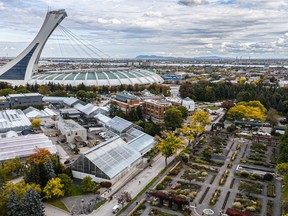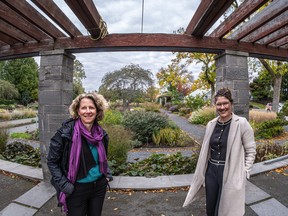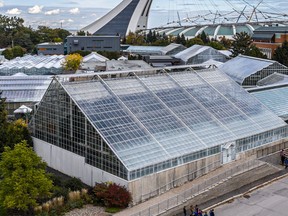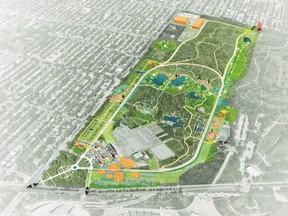Montreal is planning a major revamp of the renowned Botanical Garden, one of the most significant institutions of its kind in the world.

Article content
Montreal is planning a $450-million overhaul of its world-renowned — though aging — Botanical Garden over the next 15 years, including the replacement of its decrepit greenhouses, which have been closed to the public since January due to falling glass panes.
Some of the work has already begun, notably on the main building near the corner of Pie-IX Blvd. and Sherbrooke St. But the city’s executive committee adopted a loan bylaw Wednesday to allow the Garden to borrow up to $150 million over the next decade to shore up and eventually replace its dozens of greenhouses, which hold many rare and threatened plant species.
Advertisement 2
Story continues below
Article content
The falling glass is only the most recent and obvious sign that it’s past time to modernize the 93-year-old Botanical Garden, considered one of the five most significant such installations in the world.
Founded in 1931, when Camillien Houde was mayor and horse-drawn buggies were not uncommon in Montreal’s streets, the gardens were originally designed by landscape architect Henry Teuscher to be viewed from moving vehicles. In fact, one of the key renovations planned is the removal of some of the Garden’s wide, paved roadways to be replaced with narrower walkways and more greenery.
The Botanical Garden is part of the Espace pour la vie (Space for Life) museum complex, which is the one of the largest natural science museums in Canada. It attracts 2.7 million visitors a year to eastern Montreal, and generates about $40 million in revenues for the city annually.
The other three institutions that make up Espace pour la vie — the Planetarium, the Insectarium and the Biodôme — have all been renovated or rebuilt. The Planetarium, now called the Rio Tinto Alcan Planetarium, was moved from downtown to the Espace pour la vie site in 2013 at a cost of about $48 million. The Biodôme got a two-year, $37-million renovation and reopened in August of 2020. And the Insectarium’s new $38-million building was finally inaugurated after many delays in April 2022.
Article content
Advertisement 3
Story continues below
Article content
“Now it is the Botanical Garden that needs some love, that needs necessary investments and that’s what we are going to do,” said Caroline Bourgeois, the city’s executive committee member responsible for the Espace pour la vie museum complex.

Julie Jodoin, director of services for Espace pour la vie, said the museum complex has seen a 46 per cent increase in visitors over the last decade, which she attributes to the investments in renewal at the other three museums. The complex was responsible for an estimated $121 million in economic and tourism benefits to the city in 2023, she said, and that is projected to grow to $132 million a year with improvements to the Botanical Garden.
Named a historic site by the federal government in 2010, the 75-hectare Botanical Garden currently attracts about 800,000 visitors per year. It is comprised of 16 thematic outdoor gardens — including the Rose Garden, the Monastery Garden and the Aquatic Garden — as well as three “cultural” gardens; the Japanese, First Nations and Chinese gardens. There are also 10 exhibition greenhouses (normally open to the public) and three production complexes that house 40 separate greenhouses, a dozen of which belong to other institutions; including the Université de Montréal, the Insectarium and the Biodôme.
Advertisement 4
Story continues below
Article content
The production greenhouses serve as “archives” to the exhibition greenhouses, with plants rotated through the public greenhouses at regular intervals. There are an estimated 20,000 plants in the greenhouses and gardens, about 450 of which are considered rare.
The greenhouses were built gradually from the 1950s to the 1980s. In recent years, there have been several incidents of glass panes cracking or falling in the production greenhouses, but when a large pane came down in one of the exhibition greenhouses in early January, with members of the public present, the decision was made to close them. No one was hurt. No specific cause for the break has been identified.

“Any glassed building could be the victim of falling glass, but considering the decrepitude of our installations, considering there had been some breaks in the production greenhouses before that … that’s why we decided that it was out of our control,” said Jodoin. “The conditions did not allow us to determine whether it could happen again, so I took the immediate decision to close all the greenhouses at the beginning of January.”
Advertisement 5
Story continues below
Article content
Work has been underway to replace some of the glass plates with tempered glass, which is stronger and crumbles into small, blunt beads when it breaks, rather than large, sharp shards like single-pane glass. Other safety precautions are being added to protect the public and employees, and some of the greenhouses are expected to reopen this winter, said Garden director Josée Bellemare.
“But parallel to that, there is a project to build new greenhouses that will be much better adapted, more energy efficient, more comfortable to experience and that will allow for better conservation,” Bellemare said. “So we are working on two fronts at once, the preservation of the current greenhouses to ensure the safety of the visiting public and the people who work there, as well as the new greenhouse project.”

Espace de la vie is an important international research facility and its scientists contribute to the evolution of plant-based sciences including eco-physiology, ecotoxicology and phytotechnology. Research projects carried out at the Garden facilities are used to solve problems in Montreal and around the world, said Bellemare, offering as an example the use of phytotechnology to remove contaminants from soil in east-end Montreal.
Advertisement 6
Story continues below
Article content
“The Botanical Garden is a research space that measures up with the greatest botanical gardens in the world,” Bellemare said.
She outlined three main goals of the redevelopment plan: a 60 per cent reduction of greenhouse gas emissions through an overhaul of the fossil fuel heating system, responsible water management through an overhaul of the irrigation and draining systems, and improved inclusivity and accessibility.
Renovations to the main building have already begun, as well as some work in the western garden on a more accessible visitors’ trail. The western garden is actually nine different themed gardens, designed when the Botanical Garden first opened in the 1930s. Its pergolas have no accessible ramps and its stone walls need care and re-enforcement.
Bellemare said one of the ideas is to add a more family-friendly vibe to the western gardens. “Right now a large portion of the visitors to the garden are adults … we would like to add a space for children and families,” she said, noting that other areas of the garden will also be redesigned to be more child-friendly.
“This garden was designed with a lot of audacity in 1931. Today is the time to re-appropriate this audaciousness, and re-establish the garden for the next 100 years,” Bellemare said.
Recommended from Editorial
Advertisement 7
Story continues below
Article content
Article content


Comments